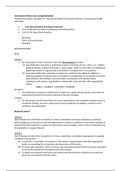International labour law and globalization
Fundamental labour standards III – Non-discrimination and equal treatment, Occupational health
and safety
I. Non-discrimination and Equal treatment
• C111 (1958) Discrimination (Employment and Occupation)
• C100 (1951) Equal Remuneration
Standards
Types of discrimination
Examples
DISCRIMINATION?
C111
Article 1
1. For the purpose of this Convention the term discrimination includes:
(a) Any distinction, exclusion or preference made on the basis of race, colour, sex, religion,
political opinion, national extraction or social origin, which has the effect of nullifying or
impairing equality of opportunity or treatment in employment or occupation;
(b) Such other distinction, exclusion or preference which has the effect of nullifying or
impairing equality of opportunity or treatment in employment or occupation as may be
determined by the Member concerned after consultation with representative
employers' and workers' organisations, where such exist, and with other appropriate
bodies
DIRECT / INDIRECT / MULTIPLE / SYSTEMIC
Exception:
2. Any distinction, exclusion or preference in respect of a particular job based on the inherent
requirements thereof shall not be deemed to be discrimination.
Context:
3. For the purpose of this Convention the terms employment and occupation include access to
vocational training, access to employment and to particular occupations, and terms and
conditions of employment.
Required action?
Article 2
Each Member for which this Convention is in force undertakes to declare and pursue a national
policy designed to promote, by methods appropriate to national conditions and practice, equality of
opportunity and treatment in respect of employment and occupation, with a view to eliminating any
discrimination in respect thereof.
Article 3
Each Member for which this Convention is in force undertakes, by methods appropriate to national
conditions and practice--
(a) To seek the co-operation of employers' and workers' organisations and other appropriate
bodies in promoting the acceptance and observance of this policy;
(b) To enact such legislation and to promote such educational programmes as may be calculated
to secure the acceptance and observance of the policy;
(c) To repeal any statutory provisions and modify any administrative instructions or practices
which are inconsistent with the policy;
, (d) To pursue the policy in respect of employment under the direct control of a national
authority;
(e) To ensure observance of the policy in the activities of vocational guidance, vocational
training and placement services under the direction of a national authority;
(f) To indicate in its annual reports on the application of the Convention the action taken in
pursuance of the policy and the results secured by such action.
Different Treatment
Article 5
1. Special measures of protection or assistance provided for in other Conventions or
Recommendations adopted by the International Labour Conference shall not be deemed to
be discrimination.
2. Any Member may, after consultation with representative employers' and workers'
organisations, where such exist, determine that other special measures designed to meet the
particular requirements of persons who, for reasons such as sex, age, disablement, family
responsibilities or social or cultural status, are generally recognised to require special
protection or assistance, shall not be deemed to be discrimination.
- “Positive discrimination”
- “Affirmative action”
- “Special protection”
Permanent Court of International Justice 1935
PCIJ “Minority Schools in Albania”
Equality in Law and in Fact:
o “Equality in law and fact not merely excludes all discrimination between the majority
and the minority, but may necessitate different treatment of the majority and the
minority so as to produce an equilibrium between their respective situations.”
European Court of Human Rights
Thlimmenos v. Greece (ECHR, 2000)
44. The Court has so far considered that the right under Article 14 not to be discriminated against in
the enjoyment of the rights guaranteed under the Convention is violated when States treat
differently persons in analogous situations without providing an objective and reasonable
justification (see the Inze judgment cited above, p. 18, § 41). However, the Court considers that this
is not the only facet of the prohibition of discrimination in Article 14. The right not to be
discriminated against in the enjoyment of the rights guaranteed under the Convention is also
violated when States without an objective and reasonable justification fail to treat differently persons
whose situations are significantly different.
Grounds of Discrimination in C111
• 7 grounds:
o Race
o Colour
o Sex
o Religion
o Political opinion
o National extraction or
o Social origin
• Evolving concept




